Have you ever found yourself searching for that heartwarming, yet heartbreaking, movie with the dog named Hachi? The story of Hachiko, a loyal Akita Inu, transcends cultures and generations, inspiring one of cinema’s most beloved canine tales. If you’re a dog lover, you’ve likely shed a tear or two watching the film, or perhaps you’ve heard whispers of the incredible true story behind it. At “Dog Care Story,” we believe every pet has a tale, but Hachiko’s is a timeless testament to unconditional love and unwavering devotion, a narrative so powerful it has been immortalized on the silver screen and etched into the hearts of millions worldwide. Join us as we explore the cinematic renditions and the profound real-life events that shaped the legend of Hachi.
The Unforgettable Story: What is the Movie with the Dog Named Hachi?
The faithful Akita Inu, Hachiko, has been the subject of several cinematic adaptations, each striving to capture the emotional depth of his extraordinary loyalty. While there are a few films, the one most people refer to when they search for “movie with the dog named Hachi” is undoubtedly the American production.
“Hachiko: A Dog’s Tale” (2009)
The most widely known and critically acclaimed adaptation is “Hachiko: A Dog’s Tale,” released in 2009. Directed by Lasse Hallström and starring Richard Gere as Professor Parker Wilson, this film beautifully reimagines Hachiko’s story for a global audience. The narrative transports the true events from Tokyo, Japan, to a quaint American town called Bedridge, Rhode Island, without losing the original’s poignant essence.
The movie chronicles the unexpected bond formed between a college professor, Parker Wilson, and an abandoned Akita puppy he discovers at a train station. Despite initial reluctance from his wife, Parker quickly becomes inseparable from the dog, whom he names Hachi. Their daily routine becomes a heartwarming ritual: Hachi walks Parker to the train station every morning and returns to greet him promptly at 5 PM when his train arrives. This simple act of devotion forms the core of their loving relationship and becomes a cherished part of the community’s daily life.
The film’s emotional turning point arrives abruptly when Professor Wilson suffers a fatal cerebral hemorrhage during a lecture and never returns home. The impact of this loss on Hachi is depicted with profound sensitivity. For the next nine years, Hachi continues his daily vigil at the train station, waiting patiently for a master who will never disembark from the evening train. This unwavering loyalty touches the lives of the station master, local vendors, and passersby, transforming Hachi into a local legend, a living symbol of steadfast love.
Richard Gere’s portrayal of Professor Wilson brings a gentle, empathetic touch to the human side of the story, making Hachi’s devotion even more palpable. The film garnered significant praise for its emotional impact and faithful depiction of the extraordinary bond between a human and their dog. Animal lovers and general audiences alike were moved to tears, recognizing the universal themes of loyalty, grief, and enduring love. The movie was largely filmed in Woonsocket, Rhode Island, where a replica of the famous Hachiko statue now stands, mirroring its Japanese counterpart. The production utilized several Akita dogs to portray Hachi at different stages of his life, meticulously capturing the breed’s distinctive appearance and dignified demeanor.
The Original Japanese Film: “Hachiko Monogatari” (1987)
Before the Hollywood rendition captured international attention, Japan produced its own film based on the beloved Akita’s life. “Hachiko Monogatari” (The Story of Hachiko), released in 1987, was a huge box-office success in Japan and is deeply revered for its authentic portrayal of the true story. Directed by Seijirō Kōyama, this version sticks closer to the original historical details, featuring the Shibuya Train Station and Professor Ueno’s actual name.
While less known globally, “Hachiko Monogatari” is celebrated for its deep cultural resonance and raw emotional power within Japan. It laid the groundwork for the international appeal of Hachiko’s story, demonstrating that this tale of loyalty could move audiences worldwide. Both films, though differing in setting and specific narrative choices, share the fundamental goal of honoring Hachiko’s incredible spirit. They serve as powerful reminders of the profound connections we share with our canine companions and the enduring impact they can have on our lives and communities. The simple yet powerful narrative of a loyal dog waiting for its master speaks volumes about the capacity for love and devotion in the animal kingdom, making the “movie with the dog named Hachi” a timeless classic.
Hachiko’s True Story: The Loyal Akita of Shibuya
The compelling narrative that forms the backbone of the “movie with the dog named Hachi” is not merely a work of fiction, but a faithful adaptation of an astounding true story. Hachiko, an Akita Inu, lived in Japan during the 1920s and 1930s, leaving behind a legacy that continues to inspire. His tale is rooted in real events, offering a profound glimpse into the unbreakable bond between a dog and his human.
A Fateful Beginning: Professor Ueno and Hachiko
Hachiko was born on November 10, 1923, on a farm in Odate City, located in the Akita prefecture of Japan. He was a purebred Akita dog, a majestic breed known for its loyalty, dignity, and courage. At the time, Professor Hidesaburō Ueno, a professor of agriculture science at The University of Tokyo, harbored a long-standing desire for a purebred Akita. After a diligent search, one of his students helped him find a suitable puppy in Odate City.
The young Akita puppy endured a long, 20-hour train journey to Tokyo. Upon his arrival at Professor Ueno’s home on January 15, 1924, the puppy was in a precarious state, initially believed to be dead. However, Professor Ueno and his partner, Yae, painstakingly nursed the frail puppy back to health over the next six months. Professor Ueno affectionately named him Hachi, meaning “eight” in Japanese, a number considered lucky in Japanese culture.
From the moment they met, a deep and unique bond blossomed between Hachi and Professor Ueno. The professor treated Hachi not merely as a pet, but as a cherished son. They were inseparable, their connection growing stronger with each passing day. Hachi found a loving home and a dedicated companion in Professor Ueno, who, in turn, discovered a loyal friend unlike any other. This deep, early connection is crucial to understanding the profound events that followed and is beautifully portrayed in the “movie with the dog named Hachi.”
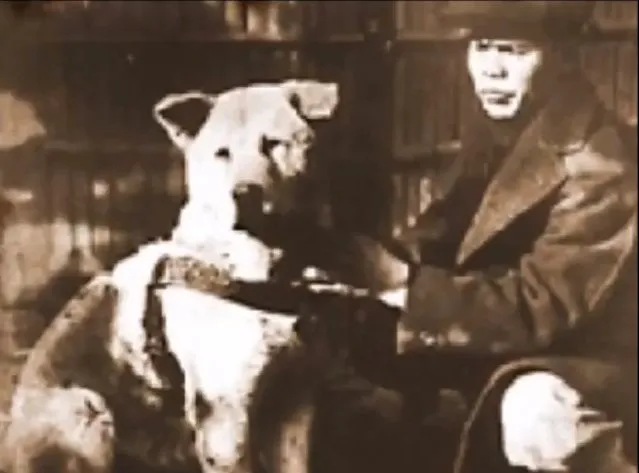 Hachiko the Akita dog sitting faithfully beside his beloved owner, Professor Hidesaburō Ueno
Hachiko the Akita dog sitting faithfully beside his beloved owner, Professor Hidesaburō Ueno
The Daily Ritual and Heartbreak
As Hachi matured, a heartwarming daily ritual began. Each morning, he would accompany Professor Ueno to Shibuya Train Station, watching his master depart for work. In the afternoon, Hachi would return to the station, eagerly awaiting Professor Ueno’s arrival and greeting him with joyful anticipation. This routine became a comforting fixture for both Hachi and the station’s regular commuters.
However, this cherished routine was tragically cut short. On May 21, 1925, just one year and four months after Hachi came into his life, Professor Ueno suffered a sudden and fatal cerebral hemorrhage while at work. He was 53 years old. Hachi, unaware of the tragedy, waited as usual at Shibuya Station, but his beloved master never appeared.
Despite the professor’s passing, Hachi’s devotion remained unshaken. He was taken in by Kozaburo Kobayashi, a former gardener for the Ueno family, whose home was conveniently close to Professor Ueno’s previous residence in Tomigaya. This proximity allowed Hachi to continue his daily pilgrimage to Shibuya Station. For the next ten years, Hachi would appear at the station every afternoon, precisely when his master’s train was due to arrive. He would sit there for hours, patiently scanning the faces of disembarking passengers, his hope unwavering, his vigil a testament to an unyielding loyalty. He waited in vain, as his dear friend and owner would sadly never return.
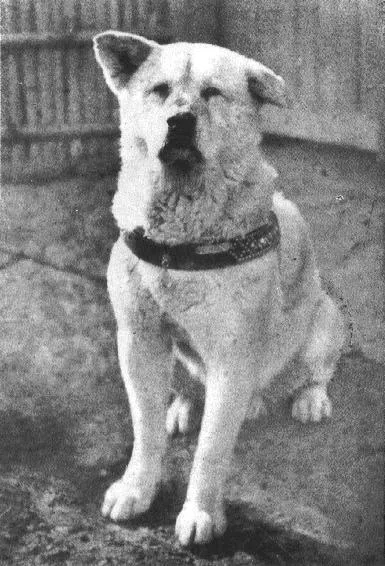 A majestic purebred Akita dog, Hachiko, standing as a symbol of loyalty and devotion
A majestic purebred Akita dog, Hachiko, standing as a symbol of loyalty and devotion
Initially, Hachi’s persistent presence at the station was met with indifference or even hostility by some pedestrians, station staff, and children, who would occasionally tease or mistreat him. They saw him as a stray, not understanding the depth of his purpose.
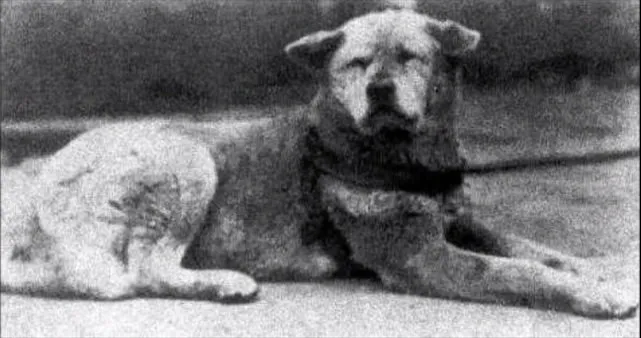 A classic black and white photo of Hachiko, the loyal dog from the famous movie, waiting patiently at Shibuya Station
A classic black and white photo of Hachiko, the loyal dog from the famous movie, waiting patiently at Shibuya Station
From Local Dog to National Hero
Hachiko’s fortunes changed dramatically in 1932. A major Japanese newspaper reporter discovered his story and published it, revealing the incredible tale of the dog who had waited almost seven years for his deceased master. The article captivated the nation, transforming Hachi from a local curiosity into a national celebrity.
People began referring to him as “Chuken Hachiko,” which translates to “Hachiko – the faithful dog.” His unwavering loyalty touched the hearts of the Japanese people and soon made him a hero. Inspired by his story, people from across Japan, and eventually the world, started visiting Shibuya Station to see Hachiko, often bringing him treats and offering him kindness. He became a powerful symbol of love, devotion, and perseverance.
Hachiko’s daily vigil at Shibuya Station continued for an astonishing nine years, nine months, and 15 days after Professor Ueno’s death. He passed away peacefully on March 8, 1935, near Shibuya Station, at the age of 11. The cause of death was later determined to be terminal cancer and a filarial infection. Even in death, his legacy of profound loyalty lived on, ensuring that the “movie with the dog named Hachi” would tell a story that resonates for generations. His story continues to be taught in Japanese schools as an example of loyalty, and his memory is cherished by millions globally, cementing his place as one of the most beloved dogs in history.
 An old Japanese newspaper clipping featuring Hachiko, the faithful Akita dog, highlighting his newfound celebrity status
An old Japanese newspaper clipping featuring Hachiko, the faithful Akita dog, highlighting his newfound celebrity status
Visiting Hachiko’s Legacy: Statues, Museums, and More
Hachiko’s story, immortalized in the “movie with the dog named Hachi,” extends far beyond the screen. His enduring legacy is commemorated in numerous monuments and locations across Japan, particularly in Tokyo and his birthplace, Odate City. These sites offer a tangible connection to the legendary Akita and allow visitors to pay their respects to a true symbol of loyalty.
Shibuya Station Hachiko Statue
The most iconic and frequently visited monument is the bronze statue located in front of Shibuya Station in central Tokyo. Erected in 1934 by Japanese artist Teru Andō, the original statue was unveiled in a grand ceremony, with Hachiko himself present as the guest of honor. Unfortunately, this original statue was melted down for metal during World War II. The current statue, a replica created in 1948 by Takeshi Ando (the original artist’s son), stands proudly today.
The Hachiko statue at Shibuya Station has become one of Tokyo’s most popular tourist attractions and a well-known meeting spot, especially among young Japanese. If you visit, you’ll notice that one of Shibuya Station’s five exits is aptly named “Hachikō-guchi,” or “The Hachikō Entrance/Exit,” a permanent tribute to his faithful wait.
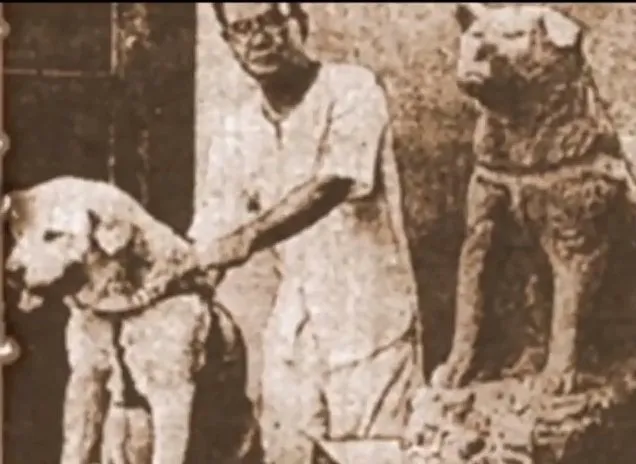 The real Hachiko standing proudly in front of his bronze statue at Shibuya Station, a tribute to his loyalty
The real Hachiko standing proudly in front of his bronze statue at Shibuya Station, a tribute to his loyalty
Every year, on March 8th, the anniversary of Hachiko’s passing, a memorial ceremony is held at Shibuya Station. This solemn event honors Hachiko’s memory and celebrates the universal values of love and loyalty he represents. The ceremony in 2023 was particularly significant, marking what would have been Hachiko’s 100th birthday, drawing a large crowd of admirers.
 Tourists and locals gathered around the iconic Hachiko statue outside Shibuya Station in Tokyo, a popular meeting spot
Tourists and locals gathered around the iconic Hachiko statue outside Shibuya Station in Tokyo, a popular meeting spot
Hachiko Mosaic at Shibuya Station
Beyond the bronze statue, Shibuya Station also features a beautiful mosaic artwork titled “Hachiko Family” on one of its walls. This vibrant mural, created by Japanese artist Ryutaro Kitahara and completed in March 1990, depicts a joyful Hachiko playing alongside his parents and siblings. It’s a colorful and heartwarming portrayal that offers a different perspective on Hachiko’s life, imagining him in a happy family setting. The mosaic is accompanied by a poem, reflecting on the square as a place of greetings and farewells, happiness and sadness, and encouraging people to meet in front of it. It adds another layer to the public’s interaction with Hachiko’s story, creating a lively visual tribute.
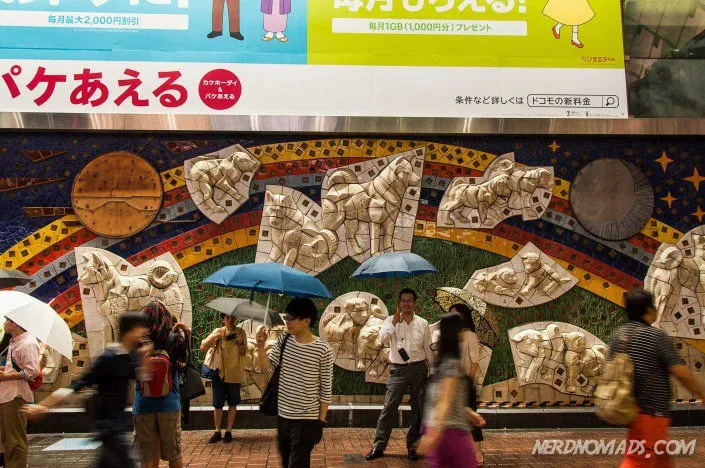 Vibrant mosaic mural titled ‘Hachiko Family’ depicting Hachiko playing joyfully with his parents and siblings at Shibuya Station
Vibrant mosaic mural titled ‘Hachiko Family’ depicting Hachiko playing joyfully with his parents and siblings at Shibuya Station
Stuffed Hachiko at National Museum of Nature and Science, Tokyo
For those who wish to see Hachiko himself, the National Museum of Nature and Science in Ueno, Tokyo, houses the preserved and stuffed remains of the loyal Akita. Hachiko passed away peacefully on a street near Shibuya Station on March 8, 1935. Given his immense status as a national symbol of loyalty and devotion, he was carefully preserved. Visiting the museum offers a unique opportunity to stand before the actual Hachiko, allowing for a deeper connection to the legendary dog from the movie with the dog named Hachi.
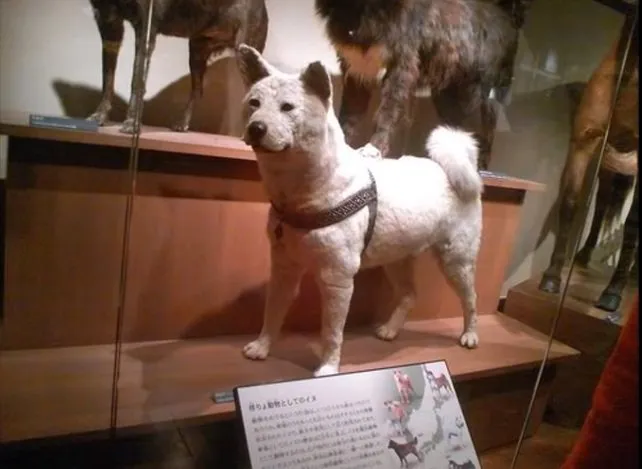 The preserved and stuffed figure of Hachiko on display at the National Museum of Nature and Science in Ueno, Tokyo
The preserved and stuffed figure of Hachiko on display at the National Museum of Nature and Science in Ueno, Tokyo
Hachiko & Professor Ueno Statue at University of Tokyo
Perhaps one of the most emotionally resonant monuments is the bronze statue of Hachiko and Professor Ueno, located at the University of Tokyo. This statue, unveiled on March 9, 2015, on the 80th anniversary of Hachiko’s death, beautifully depicts a hearty reunion between the beloved dog and his master. Created by Japanese artist Tsutomu Ueda, it captures Hachiko joyfully leaping up to greet Professor Ueno at the end of a workday at the Faculty of Agriculture, where the professor worked and tragically passed away.
This particular statue, nestled under a large tree, exudes a sense of peace and intimacy, offering a powerful visual representation of the bond that captivated the world. It provides a quiet space for reflection on loyalty, love, and devotion, away from the bustling crowds of Shibuya. Next to the statue, a small museum displays articles, photos of Hachiko, his autopsy report, and even some of his preserved organs, including his liver, heart, and lung. These exhibits offer fascinating, albeit sobering, insights into Hachiko’s life and passing, revealing that he died of natural causes related to terminal cancer and a filaria infection. This site truly brings the entire narrative, including the elements hinted at in the “movie with the dog named Hachi,” full circle.
Hachiko Monument at Professor Ueno’s Grave
While Hachiko’s fur was preserved for the museum, his remains were cremated, and his ashes were laid to rest beside his beloved master, Professor Ueno. You can visit their shared grave in Aoyama Cemetery in Minato, Tokyo. A dedicated monument to Hachiko stands beside Professor Ueno’s tomb, symbolizing their eternal bond and ensuring that they remain together in peace. This final resting place offers a profound conclusion to Hachiko’s story, echoing the emotional themes explored in the “movie with the dog named Hachi” about enduring companionship.
For those planning to immerse themselves in Tokyo’s rich cultural tapestry and Hachiko’s story, considering a stay in areas like Shinjuku or Asakusabashi can be convenient. Options range from luxurious hotels like The Park Hyatt, famed from ‘Lost in Translation,’ to mid-range stays like Tokyu Stay Shinjuku or Hotel MyStays Asakusabashi, offering comfort and amenities. Budget travelers might find MyCube by MyStays an intriguing option for a unique Tokyo experience, ensuring accessibility to all of Hachiko’s monumental sites.
dog’s way home series
The Akita Dog Museum in Odate City
To truly understand Hachiko’s origins and the heritage of his breed, a visit to the Akita Dog Museum in Odate City, Akita Prefecture, is highly recommended. Odate is known as the “capital city” of the Akita dog breed and is Hachiko’s birthplace. The museum is a treasure trove of information about the Akita Inu and its most famous ambassador, Hachiko.
Here, you can delve deep into the history and characteristics of the Akita breed, learning about their significance in Japanese culture. A special highlight for many visitors is the opportunity to meet and interact with live Akita dogs, often available on weekdays. This immersive experience allows you to appreciate the breed’s majestic presence and gentle nature firsthand. Odate City itself is adorned with various Akita dog statues and symbols, including a Hachiko statue in front of Odate Station, a Hachiko Shrine on the train platform, and even Akita figures decorating postboxes and manhole covers. It’s a city that breathes Hachiko’s legacy, offering a comprehensive look at the world of the loyal Akita. toby a dog’s purpose
Why Hachiko’s Story Continues to Resonate
The enduring popularity of the “movie with the dog named Hachi” and the global recognition of Hachiko’s true story stem from its universal appeal. Hachiko embodies themes that deeply resonate with the human spirit: unconditional love, unwavering loyalty, profound devotion, and the bittersweet nature of grief and memory. His simple, persistent act of waiting transcends linguistic and cultural barriers, speaking directly to the heart.
In a world often marked by transience and fleeting connections, Hachiko’s decade-long vigil stands as a powerful symbol of steadfastness. He reminds us of the extraordinary capacity for love that animals possess and the unique, irreplaceable bond we share with our pets. His story serves as a poignant illustration of what it means to truly love and to mourn, offering comfort and inspiration to those who have experienced loss. a dog’s journey novel
Hachiko’s influence extends beyond mere sentimentality; he has become a cultural icon, representing the highest ideals of canine companionship. For dog owners, his tale validates the deep emotional connections they share with their own furry friends. For the broader public, he represents a beacon of hope and a reminder of the pure, unadulterated love that animals bring into our lives. The movie with the dog named Hachi ensures that this incredible legacy continues to be shared with new generations, reinforcing the timeless message that loyalty knows no bounds. This powerful narrative underscores why Hachiko remains a cherished figure, his story eternally relevant in the celebration of the human-animal bond.
Exploring More Canine Stories and Resources
Hachiko’s story is just one of many tales of extraordinary canine companions that have captured our hearts. If the movie with the dog named Hachi moved you, you might be interested in exploring other narratives that celebrate the intelligence, bravery, and loyalty of dogs. From adventurous journeys to heartwarming rescues, these stories often highlight the incredible impact dogs have on human lives. a dog’s purpose toby
The world of dog care is also rich with insights into understanding and nurturing these amazing creatures. Learning about dog behavior, health, and training can deepen your bond and ensure your furry friend lives a happy and healthy life. Just as Hachiko’s story teaches us about loyalty, responsible pet ownership teaches us about commitment and care. Whether through compelling films, insightful books, or practical care guides, there’s always more to discover about our beloved canine friends. Exploring resources on breeds like the Akita, understanding their unique needs, or simply enjoying more dog-centric content can enrich your appreciation for these wonderful animals.
We, as humans, share a profound connection with dogs, often described as “man’s best friend.” Stories like Hachiko’s reinforce this belief, showcasing the depth of devotion and understanding that can exist between species. This universal appeal is why the themes of loyalty and companionship are so often explored in films and literature, offering comfort and joy to audiences worldwide. algonquin the story of a great dog
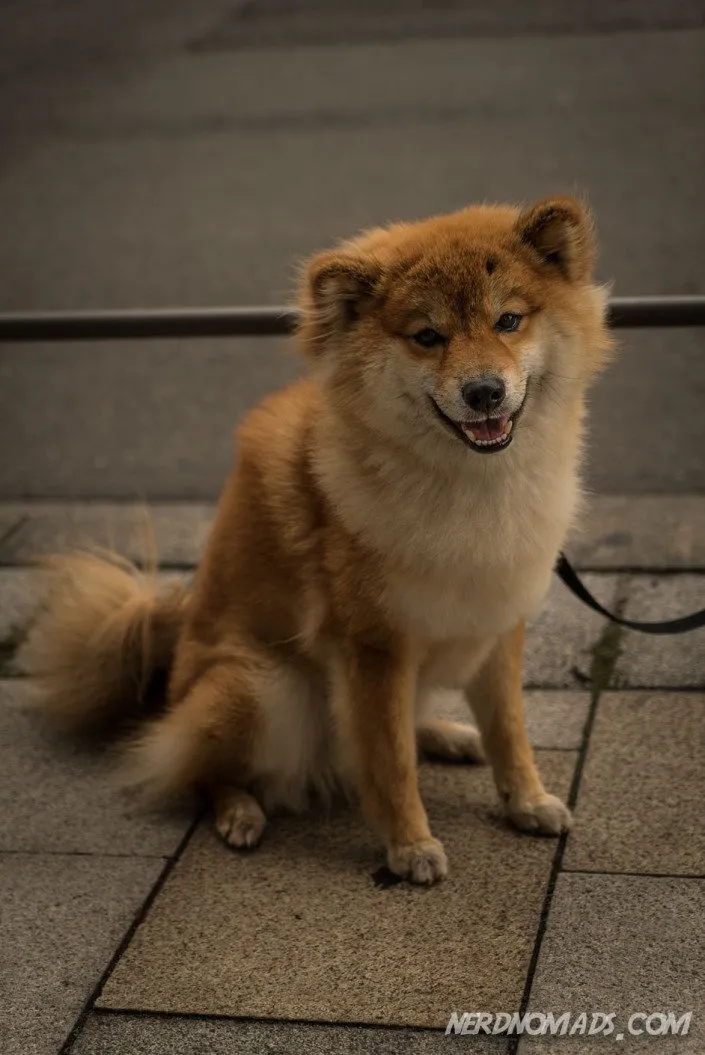 A small, adorable dog patiently waiting with its owner on a street in Japan, showcasing the country’s love for pets
A small, adorable dog patiently waiting with its owner on a street in Japan, showcasing the country’s love for pets
Our furry friends bring so much joy and unconditional love into our lives. The story of Hachiko reminds us to cherish every moment with them and appreciate the profound impact they have on our emotional well-being. From their playful antics to their comforting presence, dogs truly make our lives richer and more meaningful.
As dog lovers, the deep emotional resonance of Hachiko’s story, brought to life in the “movie with the dog named Hachi,” touches us profoundly. It’s a testament to the fact that animals, particularly dogs, can exhibit levels of loyalty and devotion that serve as powerful examples for humanity. The tears shed while watching Hachiko’s tale are a reflection of our recognition of this pure, unwavering love.
 A beautiful Siberian Husky, similar to the beloved Akita, embodying the spirit of loyal canine companions
A beautiful Siberian Husky, similar to the beloved Akita, embodying the spirit of loyal canine companions
Conclusion
The story of Hachiko, the loyal Akita Inu, stands as one of the most heartwarming and enduring tales of canine devotion. Whether you first encountered his legacy through the poignant movie with the dog named Hachi, “Hachiko: A Dog’s Tale,” or through the original Japanese “Hachiko Monogatari,” his narrative is a powerful testament to the unbreakable bond between humans and their canine companions. From his humble beginnings in Odate City to his decade-long vigil at Shibuya Station, Hachiko’s life embodied an unwavering loyalty that transcended even death, solidifying his status as a national hero in Japan and a global icon of love.
His story continues to resonate because it speaks to universal themes of commitment, love, and remembrance. The various statues and monuments across Tokyo and the Akita Dog Museum in his birthplace ensure that Hachiko’s memory remains alive and accessible to all who wish to honor his incredible spirit. We encourage you to experience his story, whether by watching the film, reading books about his life, or, if you have the opportunity, visiting the sites in Japan that bear his name. Hachiko’s legacy is a poignant reminder of the profound impact our pets have on our lives and the extraordinary capacity for love they possess. Let his story inspire us all to cherish our companions and remember the boundless loyalty that a dog named Hachi exemplified.
Sources
- Historical accounts and biographies of Hachiko, including Professor Mayumi Itoh’s works.
- Film databases and reviews for “Hachiko: A Dog’s Tale” (2009) and “Hachiko Monogatari” (1987).
- Cultural and tourism information on Shibuya Station, University of Tokyo, National Museum of Nature and Science, Aoyama Cemetery, and the Akita Dog Museum.
- Akita Inu breed standards and historical information.
